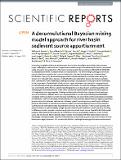| dc.contributor.author | Blake, William | |
| dc.contributor.author | Boeckx, Pascal | |
| dc.contributor.author | Stock, Brian | |
| dc.contributor.author | Smith, Hugh | |
| dc.contributor.author | Bodé, Samuel | |
| dc.contributor.author | Upadhayay, Hari | |
| dc.contributor.author | Gaspar, Leticia | |
| dc.contributor.author | Goddard, Rupert | |
| dc.contributor.author | Lennard, Amy | |
| dc.contributor.author | Lizaga, Ivan | |
| dc.contributor.author | Lobb, David | |
| dc.contributor.author | Owens, Philip | |
| dc.contributor.author | Petticrew, Ellen | |
| dc.contributor.author | Kuzyk, Zou | |
| dc.contributor.author | Gari, Bayu | |
| dc.contributor.author | Munishi, Linus | |
| dc.contributor.author | Mtei, Kelvin | |
| dc.contributor.author | Nebiyu, Amsalu | |
| dc.contributor.author | Mabit, Lionel | |
| dc.contributor.author | Navas, Ana | |
| dc.contributor.author | Semmens, Brice | |
| dc.date.accessioned | 2019-05-21T12:16:23Z | |
| dc.date.available | 2019-05-21T12:16:23Z | |
| dc.date.issued | 2018-08-30 | |
| dc.identifier.uri | | DOI:10.1038/s41598-018-30905-9 | |
| dc.identifier.uri | http://dspace.nm-aist.ac.tz/handle/123456789/123 | |
| dc.description | Research Article published by Scientific Reports | en_US |
| dc.description.abstract | Increasing complexity in human-environment interactions at multiple watershed scales presents
major challenges to sediment source apportionment data acquisition and analysis. Herein, we present
a step-change in the application of Bayesian mixing models: Deconvolutional-MixSIAR (D-MIXSIAR)
to underpin sustainable management of soil and sediment. This new mixing model approach allows
users to directly account for the ‘structural hierarchy’ of a river basin in terms of sub-watershed
distribution. It works by deconvoluting apportionment data derived for multiple nodes along the
stream-river network where sources are stratified by sub-watershed. Source and mixture samples
were collected from two watersheds that represented (i) a longitudinal mixed agricultural watershed
in the south west of England which had a distinct upper and lower zone related to topography and
(ii) a distributed mixed agricultural and forested watershed in the mid-hills of Nepal with two distinct
sub-watersheds. In the former, geochemical fingerprints were based upon weathering profiles and
anthropogenic soil amendments. In the latter compound-specific stable isotope markers based on
soil vegetation cover were applied. Mixing model posterior distributions of proportional sediment
source contributions differed when sources were pooled across the watersheds (pooled-MixSIAR)
compared to those where source terms were stratified by sub-watershed and the outputs deconvoluted
(D-MixSIAR). In the first example, the stratified source data and the deconvolutional approach provided
greater distinction between pasture and cultivated topsoil source signatures resulting in a different
posterior distribution to non-deconvolutional model (conventional approaches over-estimated the
contribution of cultivated land to downstream sediment by 2 to 5 times). In the second example, the
deconvolutional model elucidated a large input of sediment delivered from a small tributary resulting
in differences in the reported contribution of a discrete mixed forest source. Overall D-MixSIAR model
posterior distributions had lower (by ca 25–50%) uncertainty and quicker model run times. In both
cases, the structured, deconvoluted output cohered more closely with field observations and local
knowledge underpinning the need for closer attention to hierarchy in source and mixture terms in river
basin source apportionment. Soil erosion and siltation challenge the energy-food-water-environment nexus. This new tool for source apportionment offers wider application across complex environmental
systems affected by natural and human-induced change and the lessons learned are relevant to source
apportionment applications in other disciplines. | en_US |
| dc.language.iso | en_US | en_US |
| dc.publisher | Scientific Reports | en_US |
| dc.subject | Research Subject Categories::FORESTRY, AGRICULTURAL SCIENCES and LANDSCAPE PLANNING | en_US |
| dc.title | A deconvolutional Bayesian mixing model approach for river basin sediment source apportionment | en_US |
| dc.type | Article | en_US |

